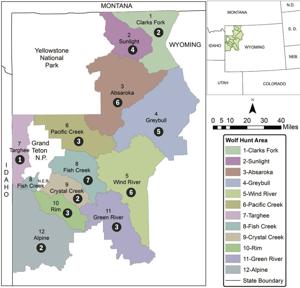■ Department visits Jackson as part of public engagement and comment tour.
By John Spina
For the first time since 2013 hunters will have a chance to hunt gray wolves in most of Wyoming this fall.
On Monday the Wyoming Game and Fish Department came to Jackson to discuss its proposals for wolf hunting quotas and regulations.
Since wolves were reintroduced to Wyoming in 1995 the wolf population has nearly reached its sustainable carrying capacity, despite losing protections for two years and then being relisted on the endangered species list in September 2014.
The spike in population, wildlife managers say, resulted in a sharp increase in livestock depredation and human-caused mortality as wolf packs traveled outside of the Trophy Game Management Area around Yellowstone and Grand Teton National Park in search of areas with fewer wolves to compete with to the south and east.
The management area will have set seasons and quotas. In the rest of the state people can kill wolves by most any means in most any situation without a license.
“Without hunting and with a stable population that was producing a lot of pups the population went up,” said Ken Mills, wolf management specialist for Game and Fish. “The distribution of wolves expanding into areas that are not suitable habitat went up, as did the number of conflicts.”
Mills reported a “record number” of cattle depredations last year — almost 150 — and sheep depredations, and 113 wolves were killed in control actions by or at the direction of the U.S. Fish and Wildlife Service.
On April 25 a court mandate returned management of gray wolves to the state of Wyoming. Starting this year it will once again allow the hunting of wolves in the Trophy Game Management Area.
With Wyoming regaining control of the management of its wolves, “we’ll look to reverse this trend,” Mills said. “We can manage livestock depredations while still having a resilient wolf population.”
The ideal population
To avoid having its management powers revoked again Game and Fish must maintain at least 100 wolves and 10 breeding partners at the end of each calendar year outside of Yellowstone and Grand Teton National Park.
It must have 150 wolves, including 15 breeding partners, in the state, including the national parks and the Trophy Game Management Area.
“There’s no other jurisdiction that has to manage wolves the way we do,” Mills said. “We have a much smaller population [compared with Idaho or Montana] and a smaller area of suitable habitat. But on the plus side Idaho and Montana can’t manage their populations; they can’t overharvest their population. We can. Essentially we’re managing a population in a brand-new way.”
Accounting for the number of pups born each spring Game and Fish estimated the ideal population to meet standards is 160 wolves. According to its data and prevalent population studies, 40 deaths a year would stabilize the population at 210 wolves. An additional 50 mortalities would reduce the population to 160 wolves and 14 breeding partners, providing room for margin of error.
With roughly 48 wolves estimated to die each year from nonhunting human causes, the hunting quota for 2017 is recommended to be 42 wolves.
“We do believe these are conservative,” Mills said, “but we have to be sure we manage for that 10 breeding pairs and 100 wolves.”
Carlton Loewer, who works as an outfitter, believes the numbers are too conservative and quotas should be higher to reduce further livestock depredation.
“Their numbers are constantly changing,” he said, “but I don’t think we’re ever going to run out of wolves.”
Asking for buffer zones
Sara Dewy, of Wyoming Untrapped, an anti-trapping advocacy group, called for stricter regulations, including a protected buffer zone around the national parks, in part to promote the wildlife-viewing tourism industry.
She and her colleagues often go to Grand Teton National Park in hopes of catching a glimpse of a wolf. When one in the pack around Shadow Mountain was killed a few years ago, she said, the pack split up and has not been seen since.
“More people are coming here to see live animals than to kill them,” she said. “I think a buffer zone is a pretty reasonable request.”
Wolves were first delisted in Wyoming and then quickly relisted following a Montana U.S. District Court decision on July 18, 2008, that made the U.S. Forest Service re-examine Wyoming’s management plan.
In 2012 gray wolves were once again delisted in Wyoming, but following a lawsuit by Earthjustice they were again relisted by a court order that deemed the state’s management plan inadequate. That decision was appealed, and wolves were delisted again April 25.
Earthjustice said it will not appeal the latest decision due to a congressional bill being debated to remove federal protections for wolves nationwide.
Wyoming Game and Fish is traveling the state presenting its case to cities around the state and collecting public comment.
Once the public engagement period is complete June 19 Mills will present the data to the Wyoming Game and Fish Commission, which will make any changes it sees fit to make and issue a final decision on the new regulations.
If approved as is gray wolf season will open Oct. 1 and close Dec. 31, except in hunting area 12, which opens Oct. 15.

